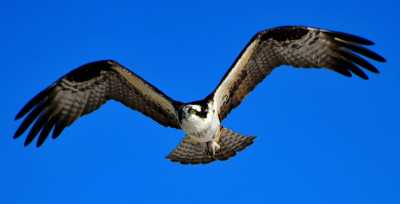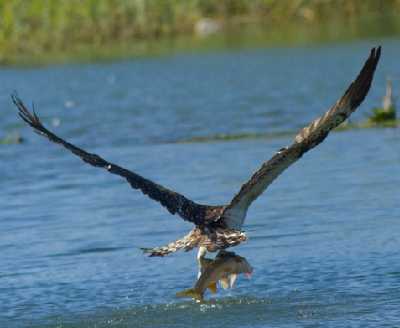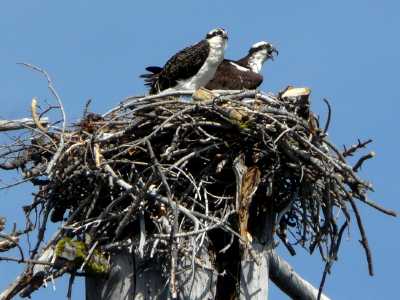 Osprey OspreyPandion
haliaetus
Description
 The osprey has a slender
body, long, narrow wings, and long legs. It flies
with a marked kink in its wings, making a
characteristic M-shape when seen from below. The osprey has a slender
body, long, narrow wings, and long legs. It flies
with a marked kink in its wings, making a
characteristic M-shape when seen from below.
Plumage is bright white underneath, with dark
brown patches at the carpal joints and a mottled
dark brown necklace. Other identifying markings
include a dark stripe through each eye, and a
dark brown back. The feet are pale blue-gray, and
the beak is black. Females often have darker
plumage and a more defined necklace than their
male counterparts. Juveniles resemble adults, but
have a somewhat speckled appearance due to
buff-colored tips on their dark brown upper-wing
and back coverts and a less well-defined
necklace. Juveniles also have an orange-red iris,
rather than the yellow iris that is typical of
adults. Juvenile plumage is replaced by adult
plumage by 18 months of age.
Adult ospreys are 21-23 inches long, have a
wingspan of 57-67 inches, and weigh 2.5-4.5
pounds. Females tend to be slightly heavier than
males and to have longer wingspans.
Distribution and
Habitat
Ospreys have a worldwide distribution,
wintering or breeding on every continent except
Antarctica. Regions where ospreys are
particularly abundant include Scandinavia and the
Chesapeake Bay region of the United States. They
can live almost anywhere where there are safe
nest sites and shallow water with abundant fish,
including lakes, rivers, wooded swamps with open
water, and shorelines, from cliffs to salt-flats.
There are four subspecies of ospreys, which
are separated by geographic region. Pandion
haliaetus carolinensis breeds in North
America and the Caribbean, and winters in South
America. P. h. haliaetus breeds in
Europe, north Africa, and in Asia, north of the
Himalayas, and winters in south Africa, India and
the East Indies. The last two subspecies are
non-migratory. P. h. ridgwayi resides in
the Caribbean, with a range that extends from the
Bahamas and Cuba to southeast Mexico and Belize. P.
h. leucocephalus is found in Australia and
the southwest Pacific.
 Diet Diet
The osprey is also known as the
fish hawk, because it feeds almost exclusively on
fish. It will take virtually any fish species
available, with size being the only limiting
factor. Ospreys have been observed taking
other prey on occasion, including birds, reptiles
and amphibians, and rodents.
"Fishing" is done on
the wing, with the osprey flying 30-130 feet
above the water. When a fish is spotted, the
osprey hovers briefly, then dives toward the
surface of the water. It swings its legs forward
and bends its wings back just before plunging
into the water and grabbing its prey. It then
uses strong, almost horizontal wing beats
to lift itself and its prey from the water. Once
airborne, the osprey rearranges the fish in its
feet, carrying it with one foot in front of the
other so that the fish is facing forward. The
fish is then taken to a perch to be eaten.
Reproduction
Non-migratory populations breed and winter in
the same location, though they may wander several
hours from their nest during the non-breeding
season. These populations begin breeding between
December and March. Migratory populations
generally breed where winters are cold enough to
drive fish into deep water where they are
inaccessible. These populations begin breeding in
April or May.
 In migratory
populations, males and females arrive at the nest
site separately, the male often arriving several
days earlier than the female. Both sexes collect
materials for the nest, but the female does most
of the nest building. Ospreys choose structures
that can support a bulky nest and that are safe
from ground-based predators. Over-water nest
sites that are often used by ospreys include
buoys and channel markers, dead trees and
artificial nest platforms. Ospreys have also been
known to nest on various man-made structures,
such as power poles, duck blinds, communication
towers, buildings and even billboards. Nests are
typically constructed of sticks and lined with
softer materials such as seaweed, kelp, grasses
or cardboard. A wide variety of flotsam and
jetsam may also be incorporated into osprey
nests, including fishing line, plastic bags and
nearly anything else that an osprey might find
and can lift. Osprey pairs use the same nest year
after year, but must spend some time each year
repairing it and adding materials before eggs can
be laid. In migratory
populations, males and females arrive at the nest
site separately, the male often arriving several
days earlier than the female. Both sexes collect
materials for the nest, but the female does most
of the nest building. Ospreys choose structures
that can support a bulky nest and that are safe
from ground-based predators. Over-water nest
sites that are often used by ospreys include
buoys and channel markers, dead trees and
artificial nest platforms. Ospreys have also been
known to nest on various man-made structures,
such as power poles, duck blinds, communication
towers, buildings and even billboards. Nests are
typically constructed of sticks and lined with
softer materials such as seaweed, kelp, grasses
or cardboard. A wide variety of flotsam and
jetsam may also be incorporated into osprey
nests, including fishing line, plastic bags and
nearly anything else that an osprey might find
and can lift. Osprey pairs use the same nest year
after year, but must spend some time each year
repairing it and adding materials before eggs can
be laid.
Once a pair has established a nest, the male
begins to deliver food to the female. This
feeding continues until the young fledge or the
nest fails. Two to four eggs are laid over a
period of several days, each 1 to 2 days apart.
Both the male and female incubate the eggs, which
hatch after approximately 40 days. The eggs hatch
in the order in which they were laid. Chicks that
hatch first are larger and have a competitive
advantage over those that hatch later.
At hatching osprey chicks are covered in white
down with brown streaks on the face, back, and
wings. This is replaced by charcoal-colored down
after approximately 10 days. Feathers begin to
replace the down at approximately two weeks and
fledging occurs after 48-76 days. After fledging,
young ospreys begin to hunt on their own, but may
continue to return to the nest to receive food
from their parents for another two to eight
weeks. Ospreys are sexually mature by their third
year, but may not breed until age five in areas
where nest sites are scarce.
Scientific
Classification
phylum Chordata
subphylum Vertebrata
class Aves
order Falconiformes
family Accipitridae
genus & species Pandion haliaetus

Animal Diversity Web http://animaldiversity.org/accounts/Pandion_haliaetus/
ARKive http://www.arkive.org/osprey/pandion-haliaetus/
Questions or comments about
this page?
|



